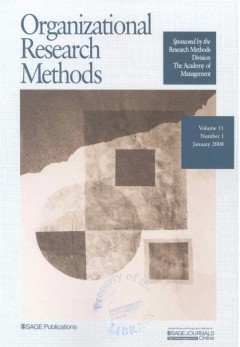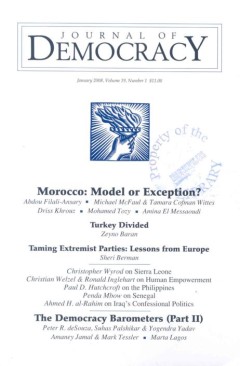Filter by

Creating digital enclaves : Negotiation of the internet among bounded religio…
This article examines the motivation behind bounded groups’ creation of digital enclaves online. Through in-depth interviews with 19 webmasters and staff of selected Israeli Orthodox websites three critical areas of negotiation are explored: (1) social control; (2) sources of authority; and (3) community boundaries. Examining these tensions illuminates a detailed process of self-evaluation whic…
- Edition
- Vol. 33 no. 5, July 2011, pp. 709-724
- ISBN/ISSN
- 01634437
- Collation
- -
- Series Title
- Media Culture Society
- Call Number
- -

Running the race : Competition discourse and broadband growth in Aotearoa New…
The objective of this study is to understand key aspects of contemporary discourse surrounding telecommunications development in Aotearoa New Zealand after the privatization of telecommunications in the late 1980s. We identify various characteristics of discourse on competition and telecommunication and trace how competition discourse was rhetorically positioned in attempts to produce economic,…
- Edition
- Vol. 33 no. 5, July 2011,pp. 725-742
- ISBN/ISSN
- 01634437
- Collation
- -
- Series Title
- Media Culture Society
- Call Number
- -

Communications and transport : The mobility of information, people and commod…
In a context where the study of communications tends to focus only on the mobility of information, to the neglect of that of people and commodities, this article explores the potential for a closer integration between the fields of communications and transport studies. Against the presumption that the emergence of virtuality means that material geographies are no longer of consequence, the role…
- Edition
- Vol. 33 no. 5, July 2011 ,pp. 743-759
- ISBN/ISSN
- 01634437
- Collation
- -
- Series Title
- Media Culture Society
- Call Number
- -

Television news and democratic change in India
This article examines the impact of India’s ‘television news revolution’, or the rapid growth of privately owned television news channels, on substantive democracy, or the ability of ordinary citizens to access social, political, and economic power. Existing scholarship has largely relied upon content analysis (or textual interpretation) and reception studies to address this question. In contra…
- Edition
- Vol. 33 no. 5, July 2011,pp. 761-777
- ISBN/ISSN
- 01634437
- Collation
- -
- Series Title
- Media Culture Society
- Call Number
- -

Digital spaces, material traces : How matter comes to matter in online perfor…
This article argues that in order to cultivate a more thorough understanding of how gender, sexuality and embodiment come to ‘matter’ in digital environments, it is necessary to reconsider the notion of the virtual as it relates to everyday reality, in addition to rethinking the digital in relation to our common conception of materiality. To develop such an understanding, the discussion is orga…
- Edition
- Vol. 33 no. 4, May 2011,pp. 531-547
- ISBN/ISSN
- 01634437
- Collation
- -
- Series Title
- Media Culture Society
- Call Number
- -

Adjusting for a Mediator in Models With Two Crossed Treatment Variables
In a simple mediation model, the effect of a manipulated variable X on a dependent variable Y over and above the effect of the mediator Me can be estimated by regressing Y on X and Me. The impact of X on Y in such a model is adjusted for the relationship both between X and Me and between Me and Y. The authors examine the adjustment function in the context of a 2 x 2 design with two manipu…
- Edition
- Vol. 11, No. 2, Page 224-240
- ISBN/ISSN
- 1094-4281
- Collation
- -
- Series Title
- Organizational Research Methods
- Call Number
- -

An Illustration of the Consequences of Meta-Analysis Model Choice
Fixed- and random-effects models represent two different approaches to analyzing and understanding data with meta-analysis. The current article describes the results of a two-part study to illustrate the effect of choice of meta-analytic model on study conclusions. Part 1 illustrates the effect of model choice by analyzing data simulated to conform to either fixed- or random-effects scena…
- Edition
- Vol. 11, No. 1, Page 35-53
- ISBN/ISSN
- 1094-4281
- Collation
- -
- Series Title
- Organizational Research Methods
- Call Number
- -

Genocide and its aftermath: The case of Rwanda
This article describes the experiences of returnees from exile into Kigali, Rwanda and the efforts of the Government of Rwanda (GoR) and the UNHCR to meet the needs of returnees, and to deal with the aftermath of the genocide. Particular attention is paid to the Gacaca courts and the role of social work therein. We identify gaps in services and make recommendations in respect of the r…
- Edition
- Vol. 51, No. 3, Page 324-336
- ISBN/ISSN
- 0020-8728
- Collation
- -
- Series Title
- International Social Work
- Call Number
- -

Taming Extremist Parties: Lessons From Europe
A rise in the power of Islamist parties has lent fresh interest to the old question of how revolutionary movements respond to participation in democracy. Pessimists argue that such movements will use any power they gain at the ballot box to subvert democracy, while optimists believe that participation can turn extremists into moderates. The example of 20th century European communist parti…
- Edition
- Vol. 19, No. 1, Page 5-18
- ISBN/ISSN
- 1045-5736
- Collation
- -
- Series Title
- Journal of Democracy
- Call Number
- -

‘Eternal ephemera’ or the durability of ‘disposable literature’ : The…
Popular and academic discussions of the future of print focus on the electronic formats of books and newspapers but ignore some of the most ubiquitous and historically significant, albeit ephemeral, types of print media. This article argues for taking the flyer, leaflet and pamphlet seriously. These forms of ‘disposable literature’ are in part facilitated by electronic media and in part able to…
- Edition
- Vol. 33 no. 4, May 2011,pp. 515-530
- ISBN/ISSN
- 01634437
- Collation
- -
- Series Title
- Media Culture Society
- Call Number
- -

Networks, cultural capital and creative labour in the British independent tel…
This article examines the significance of networking practices as a means of finding work and developing a career in the British independent television production sector (ITPS). The findings are based on qualitative research carried out between 2005 and 2006, based on in-depth interviews with 20 freelancers working in the ITPS. The article studies the importance of networking not only as a mode…
- Edition
- Vol. 33 no. 4, May 2011,pp. 549-565
- ISBN/ISSN
- 01634437
- Collation
- -
- Series Title
- Media Culture Society
- Call Number
- -

Towards ethnography of television on the internet : A mobile strategy for exp…
This article aims to expand on the currently popular practice of conducting ethnographic studies of individual online fan groups to find other ways of using the internet ethnographically for television studies. The example of the Antiques Roadshow is used to explore a strategy for ethnographic attention to the diversity of mundane engagements with a particular television text via the internet. …
- Edition
- Vol. 33 no. 4, May 2011,pp. 567-582
- ISBN/ISSN
- 01634437
- Collation
- -
- Series Title
- Media Culture Society
- Call Number
- -

Open borders, closed minds : The discursive construction of national identity…
The article investigates the discursive construction of a Turkish Cypriot national identity by the newspapers in North Cyprus. It questions the representation and reconstruction processes of national identity within the press and examines the various practices employed to mobilize readers around certain national imaginings. Using Critical Discourse Analysis, the article analyses news reports of…
- Edition
- Vol. 33 no. 4, May 2011,pp. 583-597
- ISBN/ISSN
- 01634437
- Collation
- -
- Series Title
- Media Culture Society
- Call Number
- -

Desirable people : Identifying social values through celebrity news
In this article, we define the notion of ‘celebrity news’, emphasizing the fact that the portrayal of film stars embodies the imitable and the inimitable and, consequently, points towards values. In that context, we discuss the results of a thematic content analysis of a wide corpus of the daily and weekly European, French-speaking printed media to reveal which values are highlighted in celebri…
- Edition
- Vol. 33 no. 4, May 2011,pp. 599-618
- ISBN/ISSN
- 01634437
- Collation
- -
- Series Title
- Media Culture Society
- Call Number
- -

Endangered childhoods : how consumerism is impacting child and youth identity
Modern-day children are immersed in cultures of consumption such that every aspect of their lives is touched by a buy-and-consume modality. In particular, children in North America are increasingly experiencing the effects of consumer culture at unprecedented levels of involvement. It becomes necessary, therefore, to examine the impact of consumerism in order to assess identity formation and de…
- Edition
- Vol. 33 no. 3, April 2011,pp. 347-362
- ISBN/ISSN
- 01634437
- Collation
- -
- Series Title
- Media Culture Society
- Call Number
- -

Environmental website production : a structuration approach
The World Wide Web has excited much speculation, and a growing body of scholarship, about its potential to advance the communicative power of social movement organizations. As a medium that enables online publishing, and selected features and functions, websites could be important in this regard. Yet, studies of social movement websites have documented these groups’ modest uses of the medium, a…
- Edition
- Vol. 33 no. 3, April 2011,pp. 363-384
- ISBN/ISSN
- 01634437
- Collation
- -
- Series Title
- Media Culture Society
- Call Number
- -

A definition of journalistic objectivity as a performance
Historically, journalism as a profession emerged alongside the notion of objectivity. However, in the past decades, objectivity has been dismissed not only as an unattainable standard but also as an undesirable norm. Yet an analysis of the criticisms reveals that most scholars actually fail to define journalistic objectivity. This article tries to remedy this flaw and to suggest that journalist…
- Edition
- Vol. 33 no. 3, April 2011,pp. 385-398
- ISBN/ISSN
- 01634437
- Collation
- -
- Series Title
- Media Culture Society
- Call Number
- -

Political consumerism, young citizens and the Internet
Evidence suggests that purchasing products for ethical or political reasons?also known as political consumerism?may be gaining in importance. With (young) people’s declining voting rates and a general disinterest in political institutions, scholars and political elites alike are speculating on the evolution of citizenship. Research shows that citizens in countries like the UK see issue and life…
- Edition
- Vol. 33 no. 3, April 2011,pp. 399-413
- ISBN/ISSN
- 01634437
- Collation
- -
- Series Title
- Media Culture Society
- Call Number
- -

The border-crossing of habitus : media consumption, motives, and reading stra…
Drawing on Bourdieu’s concepts of cultural capital and habitus, this study investigates media consumption, motives of media use, and reading strategies among Asian immigrant women in South Korea. The interview data from this study reveal that the total sum of media consumption among Asian immigrant informants tends to increase after immigration and that their media consumption can be regarded a…
- Edition
- Vol. 33 no. 3, April 2011,pp. 415-431
- ISBN/ISSN
- 01634437
- Collation
- -
- Series Title
- Media Culture Society
- Call Number
- -

Google ads and the blindspot debate
This article renews Dallas Smythe’s ‘blindspot’ argument by examining the economy of Google advertising. I argue that Google sells at least three types of commodities: keywords, statistics of keywords, and search results. Through a vertically integrated system, Google sells to advertisers commodities that have no exchange value outside the Google ads system. Moreover, Google creates an ideology…
- Edition
- Vol. 33 no. 3, April 2011,pp. 433-447
- ISBN/ISSN
- 01634437
- Collation
- -
- Series Title
- Media Culture Society
- Call Number
- -
 Computer Science, Information & General Works
Computer Science, Information & General Works  Philosophy & Psychology
Philosophy & Psychology  Religion
Religion  Social Sciences
Social Sciences  Language
Language  Pure Science
Pure Science  Applied Sciences
Applied Sciences  Art & Recreation
Art & Recreation  Literature
Literature  History & Geography
History & Geography